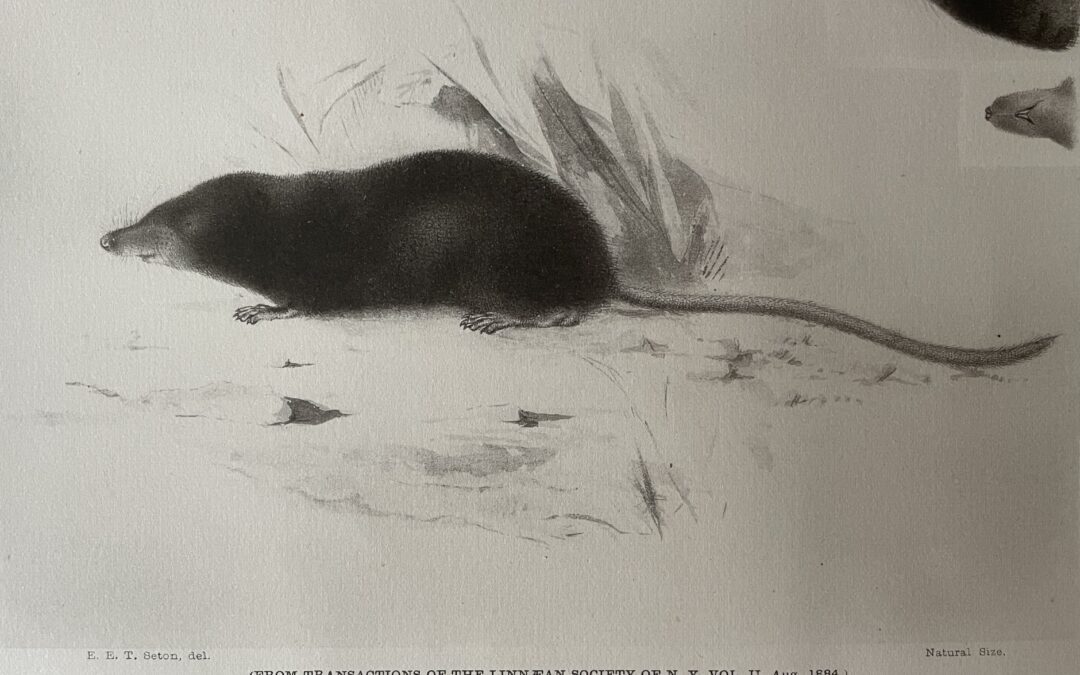Illustration by Ernest Thompson Seton, 1884
Taming of this Shrew is not a Seton wildlife story, although the daily grind of a Shrew hunting for worms and spiders might have been interesting. (Or not?) This particular little animal hero was given the special designation of its own genus and species name: Atophyrax bendirii. Later biologists returned it to closer relationship to the rest of the Shrew group. It became: Sorex bendirii otherwise known as the Marsh Shrew (and by a slew of other common names). Dr. Clinton Hart Merriam introduced the diminutive little Soricidae to the world in 1884.
An Oregon resident, an important curiosity is its ability to “walk” on water due to a natural air-enhanced fur buoyancy and according to Merriam “…like the various species of Sorex proper…it is a marsh species, dwelling in wet meadows, and occasionally taking to the water either in pursuit of its prey or as a mean of escape from its enemies.”
Forever uncredited: the dog who caught this specimen and provided it intact to “Captain Chas. E. Bendire, Ist Cavalry, U.S.A.” who passed it along to Merriam and thence to Seton. In my view, it should have been named for the dog.
Dr. Merriam—before he was a doctor—met the famous naturalist Spencer F. Baird, and as an adult was a contemporary of Elliott Coues. All three served as mentors for the young Ernest Thompson Seton.
Seton first came to their attention as an artist-illustrator, and only later as a naturalist in his own right. Merriam recognized Seton’s extraordinary talent and provided a significant career boost. Including, it would seem, giving Seton an early formal introduction to the world of science by commissioning this illustration.
What’s In a Name
But what caught my attention was how Seton was credited. Like the Marsh Shew, Seton was a creature of many names and nick names, most of which he gave himself. Born Ernest Evan Thompson, he first became famous as Ernest Seton-Thompson with Wild Animals I Have Known in 1898. But all along, it was the final version by which we know him that he favored and made public by 1902 with his Woodcraft articles in Ladies Home Journal.
How then to explain this? Merriam wrote at the end of his Shrew article: “For the very accurate drawings accompanying this paper I am indebted to the kindness of Mr. Ernest E.T. Seton, who executed them, under my supervision, from the [preserved] alcoholic specimen.”
Young Ernest Evan Thompson legally became Ernest Thompson Seton in 1877 at the age of eighteen. He was known by several name variations during the next two decades, but generally ending in Thompson.
But in this, perhaps his first big break and introduction to the profession of naturalists, he chose to go by the last name of Seton. Afterwards, “Seton” disappeared beneath “Thompson” for a long time. Seton suggested that, while continuing to remain legally Seton all along, he made his early trade name Thompson in deference to the wishes of his mother.
Citation
A New Genus And Species Of The Sorecidae (Atophyrax bendirii Merriam.) By Clinton Hart Merriam, M.D. Issued August 28, 1884. From The Transactions of the Linnaean Society of New York, Vol. II, 1884. Illustration credited to: E.E.T. Seton, del. At Natural Size.

